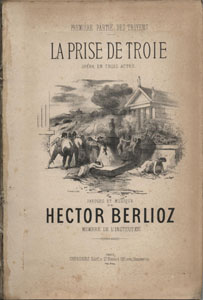
![]()

 |
|

|
Introduction
Sibelius
Technical notes
Available Scores
This page is also available in French
Copyright notice: The texts, photos, images and musical scores on all pages of this site are covered by UK Law and International Law. All rights of publication or reproduction of this material in any form, including Web page use, are reserved. Their use without our explicit permission is illegal.
![]()
The section entitled Berlioz Music Scores was created on 1 January 2000; its aim was to present on this website a collection of music by Berlioz in full score which could be viewed and played back online. This was made possible by the music notation programme Sibelius, utilising the versions available at the time, at first version I.4 (down to April 2004), with which most of the scores were notated between 2000 and 2002, then in a few cases version 3.1 (from May 2004 onwards). As part of its system Sibelius developed a special plug-in called Scorch, which was freely available to download. The Scorch plug-in made it possible to view and play back on computer Sibelius files displayed on websites such as this one.
The Sibelius programme relied for its scores on Midi sounds, i.e. computer-generated approximations of all the relevant orchestral instruments (wind, brass, percussion, strings), not sampled sounds of actual instruments as later versions of the programme do (MIDI stands for Musical Instrument Digital Interface). The Midi system has both advantages and disadvantages. It makes possible for a computer equipped with a sound card (as most computers are) to simulate a rough approximation of what instrumental and orchestral music should sound like, though this can never be a substitute for real instruments played by musicians. It also has the advantage that files with Midi sounds (as those created by the Sibelius programme) are fairly compact, as compared with files involving sampled sounds or files of actual recordings, which are much larger. The major disadvantage is that Midi can only simulate instruments, not words sung by voices. This means that with Sibelius it was only possible to reproduce, and in a rudimentary way, scores of orchestral and instrumental music by Berlioz, not his vocal music, which constitutes a major part of his output: notably his 3 operas (Benvenuto Cellini, les Troyens, Béatrice et Bénédict), the major choral works (especially the Requiem and the Te Deum), large-scale works involving voices (Lélio ou le retour à la vie, la Damnation de Faust, l’Enfance du Christ and others), and all his songs (the song cycle les Nuits d’été, la Captive and others).
The collection as it now stands adds up to over 2000 pages of full score, and over 7 hours of playing time. It comprises the following works (see the summary history of this section on a separate page):
The only orchestral work of importance that is not included in this collection is Berlioz’s arrangement of Léopold de Meyer’s Marche marocaine, which is only available in the New Berlioz Edition and is therefore subject to copyright.
With a few exceptions the list virtually excludes all the choral, vocal and operatic music of Berlioz, except in so far as it includes some purely orchestral music: this is an unavoidable consequence of the Midi system. On other limitations of the Midi system see further the Technical notes below.
The scores were all notated manually on computer (not scanned). For copyright reasons use was made of older editions of Berlioz’s music that are now in the public domain (including in some cases the Breitkopf and Härtel edition of Berlioz’s works, despite its known limitations). These older editions cannot and do not lay claim to the authenticity and authority of the New Berlioz Edition, which is now the definitive reference for all Berlioz’s music.
![]()
As mentioned above, use was made of the music notation programme Sibelius (version I.4 till April 2004, version 3.1 for new scores created from May 2004 onwards). Since then events have moved on (the following remarks also apply to the scores included in the section Berlioz: Predecessors and Contemporaries). In 2006 Sibelius was sold to the California-based company Avid; Avid initially continued to develop Sibelius with the original London-based team of programmers, but in 2012 they closed down that team while continuing to use the Sibelius name, and the programme has been further developed since. Then around 2014 Avid decided to terminate the development of the Scorch plug-in as an integral part of the Sibelius software; it may still be downloaded from the Avid website, but there is no certainty that it will continue to work with browsers after that date.
Given this decision there seems no point in trying to revise the existing scores using a later version of Sibelius. The original scores in Scorch format will continue to be available on this site as before, but in view of the uncertain future of the Scorch format it has been decided to provide the scores also in pdf format (the same applies to the scores in Predecessors and Contemporaries). These pdf files were created some time ago from the original Sibelius scores, and are identical to them as far as the notation goes; the advantage of the universal pdf format is that it is not likely to become obsolete. Links to these pdf files will be found on the separate pages devoted to individual scores, which are listed below.
While the original Sibelius and Scorch files have not been modified since their creation, the pages of text associated with indivual scores have been extensively revised and enlarged between September 2021 and June 2022; they now provide much fuller detail on the individual works than the original versions, and include numerous links to other sections on the website that were created in the intervening years. Please note that the letter H followed by a number, which is found on all the pages dealing with individual scores, refers to entries in D. Kern Holoman, Catalogue of the Works of Hector Berlioz (Bärenreiter 1987, volume 25 of the New Berlioz Edition). This reference work includes a comprehensive collection of the evidence concerning the composition, publication and performance of Berlioz’s works in his lifetime, and extensive use has been made of it throughout this section.
Mention should also be made here of other sections of the website that are of particular relevance:
![]()
For the playback of these scores the Midi format has been used by Sibelius because of its universality, though several obvious limitations should be mentioned. These concern partly the format itself, partly its implementation in Sibelius. Please note that the following remarks apply to the earlier versions of the Sibelius programme that were used in creating the scores presented on this page.
![]()
![]() Fugue for the Prix de Rome competition (1829)
Fugue for the Prix de Rome competition (1829)
![]() Symphonie fantastique (complete) (I: Rêveries. Passions II: Un Bal (in two
versions, without and with solo cornet) III: Scène aux champs IV: Marche au supplice V: Songe d’une Nuit du Sabbat)
Symphonie fantastique (complete) (I: Rêveries. Passions II: Un Bal (in two
versions, without and with solo cornet) III: Scène aux champs IV: Marche au supplice V: Songe d’une Nuit du Sabbat)
![]() The Aeolian Harp, from Lélio ou le retour à la vie
The Aeolian Harp, from Lélio ou le retour à la vie
![]() Harold en Italie (complete)
(I: Harold aux montagnes; II: Marche des pélerins; III: Sérénade; IV: Orgie de brigands)
Harold en Italie (complete)
(I: Harold aux montagnes; II: Marche des pélerins; III: Sérénade; IV: Orgie de brigands)
![]() Roméo et Juliette: Orchestral excerpts (I: Introduction; II: Romeo alone – Festivities at the Capulets; III: Love scene; IV: Queen Mab Scherzo; VI: Romeo at the tomb of the Capulets)
Roméo et Juliette: Orchestral excerpts (I: Introduction; II: Romeo alone – Festivities at the Capulets; III: Love scene; IV: Queen Mab Scherzo; VI: Romeo at the tomb of the Capulets)
![]() Symphonie funèbre et triomphale (complete) (I: Marche Funèbre; II: Oraison Funèbre; III: Apothéose, 1st and 2nd version)
Symphonie funèbre et triomphale (complete) (I: Marche Funèbre; II: Oraison Funèbre; III: Apothéose, 1st and 2nd version)
![]() Rêverie et caprice, Romance for violin and orchestra
Rêverie et caprice, Romance for violin and orchestra
![]() Weber: Invitation to the Dance (op. 65) (version orchestrated by Berlioz; original version for piano)
Weber: Invitation to the Dance (op. 65) (version orchestrated by Berlioz; original version for piano)
![]() 3 Pieces for Alexandre’s melodium organ
3 Pieces for Alexandre’s melodium organ
![]() Marche d’Isly (Léopold de Meyer; orchestration by Berlioz [?] and original version for piano)
Marche d’Isly (Léopold de Meyer; orchestration by Berlioz [?] and original version for piano)
![]() La Damnation de Faust:
3 orchestral pieces (Hungarian March, Ballet des Sylphes, Menuet des Follets)
La Damnation de Faust:
3 orchestral pieces (Hungarian March, Ballet des Sylphes, Menuet des Follets)
![]() Te Deum:
Prelude (originally the 3rd movement) and March for the Presentation of the
Colours (8th movement)
Te Deum:
Prelude (originally the 3rd movement) and March for the Presentation of the
Colours (8th movement)
![]() Chant des Chérubins and Pater Noster (Bortniansky; arrangement by Berlioz [?])
Chant des Chérubins and Pater Noster (Bortniansky; arrangement by Berlioz [?])
![]() L’Enfance du Christ:
instrumental excerpts (Nocturnal March, Dance of the Sooth-Sayers [from Part I]; Overture to La Fuite en Egypte and orchestral introduction to Le Repos de la Sainte Famille [from Part II]; Trio for 2 flutes and harp [from Part III])
L’Enfance du Christ:
instrumental excerpts (Nocturnal March, Dance of the Sooth-Sayers [from Part I]; Overture to La Fuite en Egypte and orchestral introduction to Le Repos de la Sainte Famille [from Part II]; Trio for 2 flutes and harp [from Part III])
![]() Funeral March for the last scene of Hamlet, from Tristia, no.3
Funeral March for the last scene of Hamlet, from Tristia, no.3
![]() Valse chantée par le vent dans les cheminées d’un de mes châteaux en Espagne
Valse chantée par le vent dans les cheminées d’un de mes châteaux en Espagne
![]() Les Troyens: Orchestral excerpts (Combat de Ceste, from Act I; Act II Scene 1; Lamento for Les Troyens à Carthage; 3 entrances from Act III; Trojan march in the minor key from Act III; Royal Hunt and Storm; 3 ballets from Act IV)
Les Troyens: Orchestral excerpts (Combat de Ceste, from Act I; Act II Scene 1; Lamento for Les Troyens à Carthage; 3 entrances from Act III; Trojan march in the minor key from Act III; Royal Hunt and Storm; 3 ballets from Act IV)
![]() Béatrice et Bénédict: Overture and Sicilienne
Béatrice et Bénédict: Overture and Sicilienne
A Summary history of these pages is available on this site.
![]()
The Hector Berlioz Website was created by Michel Austin and Monir Tayeb on 18 July 1997;
Berlioz Music Scores pages created on 1 January 2000 (English version) and on 2 January 2000 (French version). Revised on 1 July 2022.
© Michel Austin for all scores and text on these pages; all rights of reproduction reserved.